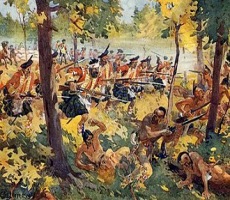Witness a clash of cultures as historical reenactors bring the Battle of Bushy Run to life! Each year, the BRBHS commemorates the Battle of Bushy Run on the first Saturday and Sunday in August with a large-scale, reenactment. Visitors will learn firsthand what caused Native American warriors and British soldiers to take up arms against each other during a two-day battle in August 1763 during Pontiac’s War. They will also discover what life was like on the frontier for European settlers and Native peoples alike in this historical reenactment.
In addition to the reenactments occurring on both Saturday and Sunday, events include morning historical demonstrations, eighteenth century military camps, a Native American village, a sutler trade area, live historical music, a children’s area, concession stand, and more!
260TH ANNIVERSARY OF THE BATTLE OF BUSHY RUN EVENT DETAILS:
Date: August 5-6, 2023
Time: 10:00 am – 4:00 pm (Saturday and Sunday)
Battle of Bushy Run website
Battle of Bushy Run Information
The Battle of Bushy Run was a significant conflict that occurred during Pontiac’s War, a Native American uprising against British rule in the Great Lakes region of North America. The battle took place on August 5-6, 1763, near present-day Harrison City, Pennsylvania.
At the time, the British controlled a number of forts and trading posts in the Ohio Country, which were vital for maintaining their influence over Native American tribes and the fur trade. However, in the aftermath of the French and Indian War, tensions arose as the British implemented new policies and restricted trade, leading to discontent among the Native American tribes.
Under the leadership of Chief Pontiac, an alliance of several Native American tribes launched coordinated attacks on British-held positions. One of their targets was Fort Pitt (formerly Fort Duquesne), located at the confluence of the Ohio and Monongahela Rivers.
To relieve the siege on Fort Pitt, Colonel Henry Bouquet, a British officer, led a force of around 500 soldiers, including the 42nd Highland Regiment (known as the Black Watch), towards the fort. As they advanced through the Pennsylvania wilderness, the British forces were ambushed by a large force of Native American warriors on August 5.
The Native Americans employed guerrilla tactics, using the dense forest and underbrush to their advantage. They launched frequent attacks on the British column, inflicting heavy casualties and causing significant disruption. The British, however, were able to hold their ground and maintain their defensive formations.
Recognizing the danger they faced, Colonel Bouquet ordered his troops to construct a fortified camp on the high ground, establishing a defensive position known as “Bouquet’s Camp.” This fortified camp provided protection and allowed the British to repel further Native American assaults throughout the night.
On the following day, August 6, the Native American warriors launched another fierce attack on the British position. However, the disciplined and well-organized British soldiers, supported by artillery fire, managed to repulse the Native American assaults and inflict significant casualties on their attackers.
As the battle progressed, the Native American warriors gradually withdrew, realizing that their attempts to overwhelm the British forces were unsuccessful. The British, having successfully defended their position, pursued the retreating Native Americans for a short distance before ultimately returning to Bouquet’s Camp.
The Battle of Bushy Run was a decisive victory for the British. Their ability to hold their ground against the Native American warriors and successfully defend their position ensured the survival of the relief column and safeguarded Fort Pitt.
Following the battle, Colonel Bouquet and his forces proceeded to Fort Pitt, where they lifted the siege and reinforced the fort’s defenses. The British victory at Bushy Run played a significant role in the overall outcome of Pontiac’s War, as it weakened Native American resistance and bolstered British control in the Ohio Country.
Today, the Bushy Run Battlefield is a National Historic Landmark, preserving the site of the battle and providing visitors with the opportunity to explore the battlefield, view interpretive exhibits, and gain insights into the events and significance of the Battle of Bushy Run.
